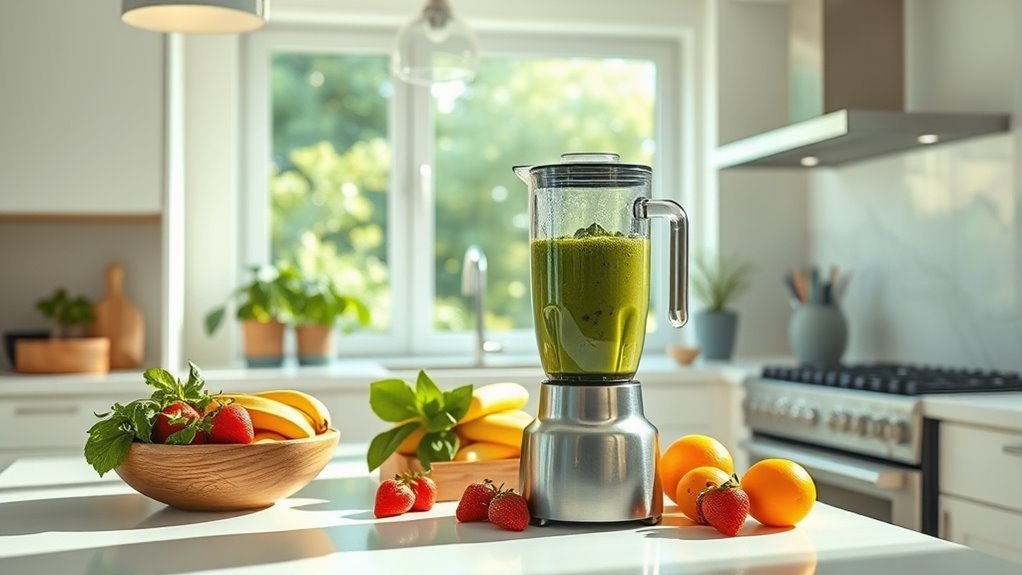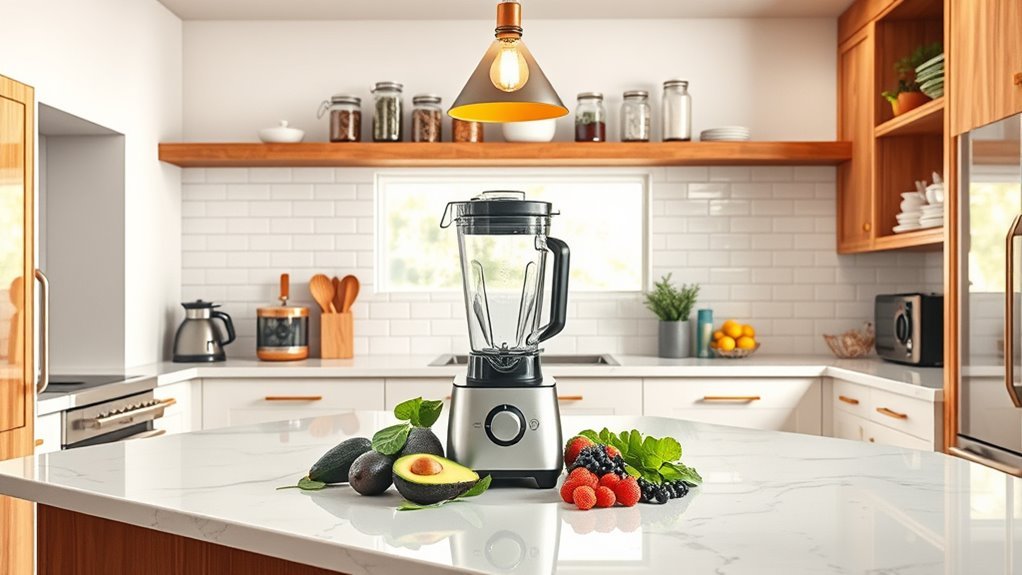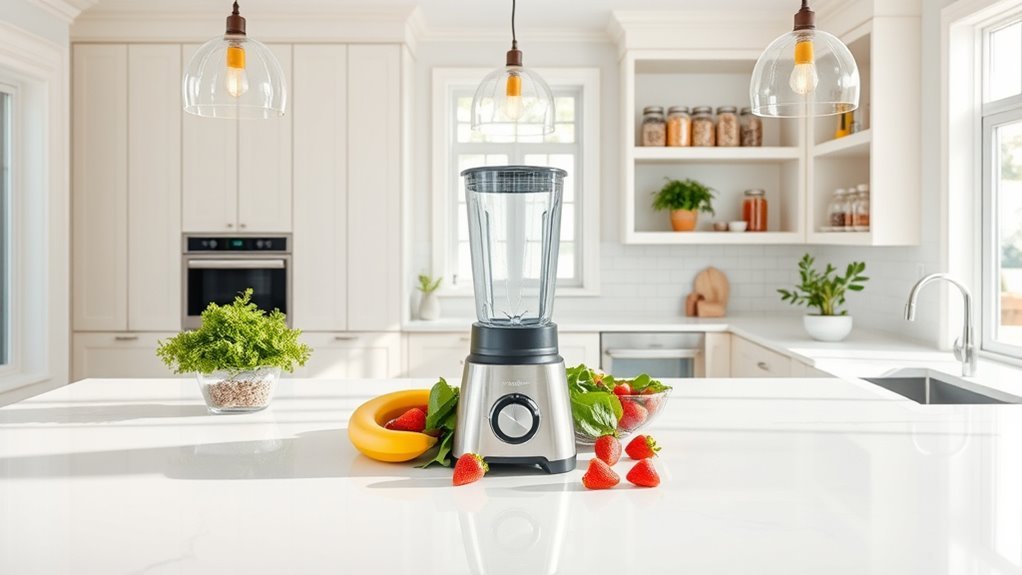We can quiet even the noisiest blenders through strategic sound dampening and smart operation. Place a thick rubber mat or dish towel under the base to absorb vibrations. Position your blender away from walls and corners to minimize echo. Run it in short bursts rather than continuous operation. For serious noise reduction, construct a custom soundproof box with acoustic foam lining. These foundational techniques are just the start of your path to peaceful blending.
Understanding Why Blenders Make Noise

While most kitchen appliances make some noise, blenders are particularly notorious for their ear-splitting racket.
Let’s break down why your blender noise is reaching such extreme levels. The culprits? Powerful motors running at speeds up to 35,000 rpm, creating intense friction as blades slice through ingredients.
We’re dealing with multiple noise sources here. Your noisy blender isn’t just about the motor – it’s the vibrations transferring through your countertop, especially on hard surfaces.
Those loose parts rattling around? They’re adding unnecessary screeching to the mix. Think of your blender as a symphony of sound-producing elements working in perfect chaos. High-performance blenders, known for their powerful motors, can significantly reduce blending time and noise levels.
Understanding these components is essential for implementing effective soundproofing techniques, from sound enclosure solutions to strategic placement. The better we grasp the noise sources, the smarter we can silence them.
Simple DIY Solutions for Quieter Blending
Three simple DIY hacks can transform your blender from a noisy nightmare into a more manageable appliance.
We’ll show you how to tame those powerful blenders using readily available materials and smart positioning.
Here’s what you need to implement:
- Place a thick dish towel or sound dampening mat under your blender to absorb vibrations.
- Build a soundproof box using MDF or plywood, lined with acoustic foam panels.
- Install self-adhesive dampening pads under the blender’s feet.
- Position the appliance away from hard surfaces and walls.
Run your blender in short bursts instead of continuous operation – it’s an easy way to reduce overall noise.
Remember, proper placement matters: keep it on a sturdy table or kitchen island rather than against sound-reflecting surfaces. High-performance blenders, which often exceed 1,000 watts of motor power, can generate more noise, so these solutions are especially beneficial.
These solutions work together to create a considerably quieter blending experience.
Smart Placement Strategies to Reduce Sound

Beyond the DIY solutions we’ve covered, smart positioning can dramatically reduce your blender’s noise footprint.
Let’s tackle smart placement strategies that’ll make a real difference in how much noise your blender produces.
First, center your blender on a sturdy table or kitchen island – this is essential to minimize echo and sound reflections.
Never place it in corners or against walls, as these create an enclosed space that amplifies noise.
We recommend keeping ample clearance around the unit to prevent sound wave reflections from bouncing back.
If you’re dealing with concrete or hard walls, use an extension cord to position the blender further away.
And don’t forget to check your blender’s manual – manufacturers often include ideal placement recommendations specific to your model’s sound characteristics.
Essential Equipment for Sound Dampening
The right sound dampening equipment can make the difference between a peaceful morning smoothie and an earthquake in your kitchen.
We’ve tested dozens of solutions, and here’s what actually works to reduce noise and absorb vibrations:
- Sound dampening pads or rubber mats (1/4 to 1/2 inch thick) placed directly under your blender’s feet
- A custom soundproof box lined with acoustic foam panels – build it yourself using MDF or plywood
- Ready-made acrylic sound enclosures that slip right over your blender
- Multiple layers of thick dish towels or a reinforced cardboard box for quick sound absorption
Don’t waste time with flimsy solutions.
These proven tools will dramatically quiet your blender, letting you blend away without waking the neighborhood.
Trust us – your family (and neighbors) will thank you.
Best Practices for Noise-Minimized Operation

While sound-dampening equipment plays an essential role, your blending technique can make or break the noise level.
Let’s tackle the most powerful ways to minimize blender noise during operation.
First, run your blender in short bursts instead of continuous operation – it’s a game-changer for reducing that high-pitched sound we all hate.
Next, place a thick towel or rubber mat under the unit to absorb vibrations.
We’ve found that smart ingredient choices make a huge difference too – skip those rock-hard ice cubes and whole nuts that create excessive noise.
Before blending, check that all rubber cushions are secure and tighten any loose parts to prevent rattling.
And here’s a social hack: time your blending when household members are already up and active. Your family will thank you.
Professional Sound-Reduction Methods and Tools
Professional sound-reduction tools have revolutionized how we tame unruly blender noise in commercial and home kitchens.
We’ll show you proven methods to make sure your blender operates with less noise and minimal disruption.
Here’s what you’ll need for maximum noise reduction:
- A high-quality sound-dampening mat (1/4 to 1/2 inch thick) made of silicone, rubber, or foam
- Self-adhesive sound dampening pads for direct installation under blender feet
- A sturdy soundproof box constructed with MDF or plywood, lined with acoustic foam panels
- A pre-made blender sound enclosure for those wanting a ready-to-use solution
These professional-grade tools work together to create multiple barriers against noise transmission.
Install them properly, and you’ll transform your loud blender into a surprisingly quiet kitchen companion.
Frequently Asked Questions
Is There a Way to Make a Blender Quieter?
Like taming a roaring lion, we can quiet our blender using sound dampening materials under it, adding foam insulation around it, or placing it in a specially designed noise-reducing enclosure.
Can Neighbors Hear a Blender?
Yes, neighbors can hear blender noise, as it travels through walls at 70-90 dB. We’d recommend using sound dampening techniques like rubber mats or scheduling blending during daytime to minimize residential disturbance.
Why Is My Blender so Loud?
Like a jet engine in miniature, our blenders get loud due to high-speed motors (up to 35,000 rpm), blade friction, hard ingredients, and vibrations transferring through countertops during operation.
Does a Quiet Blender Exist?
Yes, we’re seeing many high-performance blenders with noise reduction features today. Consumer reviews confirm that models like Vitamix and Hamilton Beach offer effective soundproofing options for a quieter kitchen experience.

